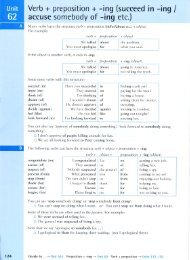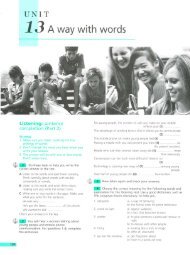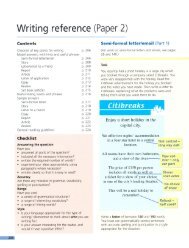I Vo.t are going to hear a news broadcast. Before you listen,look at ...
I Vo.t are going to hear a news broadcast. Before you listen,look at ...
I Vo.t are going to hear a news broadcast. Before you listen,look at ...
Create successful ePaper yourself
Turn your PDF publications into a flip-book with our unique Google optimized e-Paper software.
L Defining rel<strong>at</strong>ive clauses<br />
Defining rel<strong>at</strong>ive clauses tell us some<br />
essential inform<strong>at</strong>ion about the things or<br />
people they refer <strong>to</strong>:<br />
The picture th<strong>at</strong> hangs nefr <strong>to</strong> Marg<strong>are</strong>t's<br />
portrait is the one I liLee best.<br />
If we remove the words th<strong>at</strong> hangs next <strong>to</strong><br />
Marg<strong>are</strong>t's portait we don't know which<br />
picture Jasper is talking about.<br />
Defining rel<strong>at</strong>ive clauses:<br />
. may begin with the rel<strong>at</strong>ive pronouns uho<br />
(for people), which (for things) , th<strong>at</strong> (for<br />
things and people).<br />
I may have who, which or th<strong>at</strong> as the subject<br />
or object of the rel<strong>at</strong>ive clause:<br />
... the picture which / th@t hangs next <strong>to</strong><br />
Marg<strong>are</strong>t's portait ... (which/ th<strong>at</strong> is the<br />
subiect of the rel<strong>at</strong>ive clause)<br />
... the woman who / th<strong>at</strong> he mamied ...<br />
(who /th<strong>at</strong> is the obiect of the rel<strong>at</strong>ive<br />
clause, and he is the subject)<br />
t very often omit the rel<strong>at</strong>ive pronoun when<br />
it is the object of the rel<strong>at</strong>ive clause:<br />
The painting we're <strong>look</strong>ing <strong>at</strong> now ... or The<br />
painting which / th<strong>at</strong> we're looleing et now ...<br />
a <strong>are</strong> never separ<strong>at</strong>ed from the rest of the<br />
sentence by commas.<br />
i <strong>are</strong> used in writing and speaking.<br />
2 Non-defininEl rel<strong>at</strong>ive clauses<br />
Non-defining rel<strong>at</strong>ive clauses tell us some<br />
extra inform<strong>at</strong>ion about the things or<br />
people they refer <strong>to</strong>:<br />
The next painting shows Edmund's wife<br />
Marg<strong>are</strong>t, who he manieil in 1605.<br />
If we remove the words who he married in<br />
'L605, we still know who jasper is talking<br />
about. It is Edmund's wife, Marg<strong>are</strong>t.<br />
Non-defining rel<strong>at</strong>ive clauses:<br />
c always begin with the rel<strong>at</strong>ive pronouns<br />
who (for people) andwhich (for things).<br />
i may have who or which @ut never th<strong>at</strong>)<br />
as the subject or object of the rel<strong>at</strong>ive<br />
clause:<br />
The building, whi.ch is uery old, costs a lot<br />
of money <strong>to</strong> repair. (not t@d)<br />
The castle's owner, who we'ue just seen,<br />
enj oys meeting uisi<strong>to</strong>r s. (not tWte<br />
jas+seeft)<br />
t never omit the rel<strong>at</strong>ive pronoun.<br />
a must be separ<strong>at</strong>ed from the rest of the<br />
sentence by commas.<br />
a <strong>are</strong> more common in writing than<br />
in speaking.<br />
A We always omit the object pronoun (her, him, it, etc.) when we make a<br />
rel<strong>at</strong>ive clause:<br />
We know little about the woman th<strong>at</strong> he manieil. (not th*woman*a+4r<br />
m#ried+er)<br />
The next painting shows Edmund's wife Marg<strong>are</strong>t, who he mamieil in 1605.<br />
(not@<br />
201,


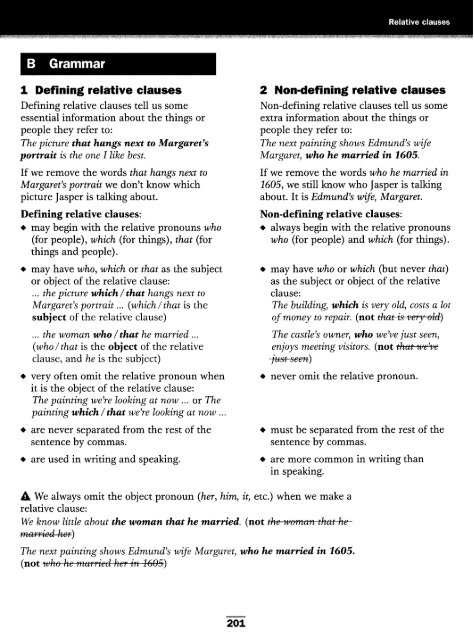
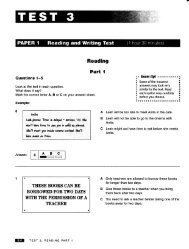
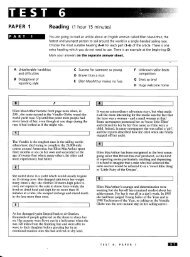
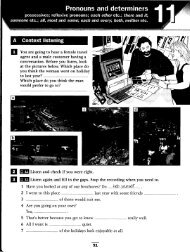
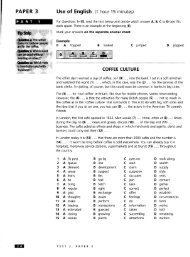
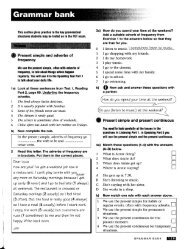
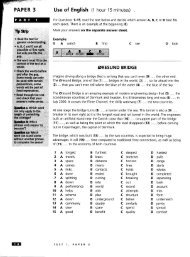


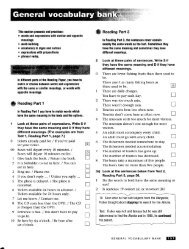
![T]NIT 9 A new look](https://img.yumpu.com/40125756/1/190x248/tnit-9-a-new-look.jpg?quality=85)
